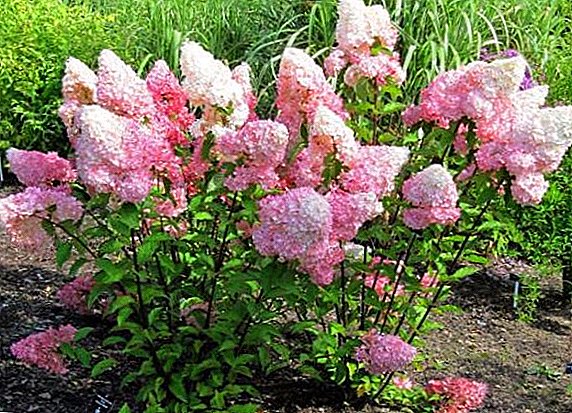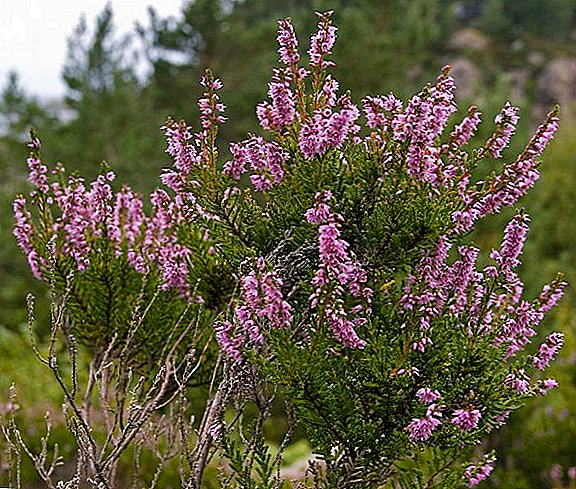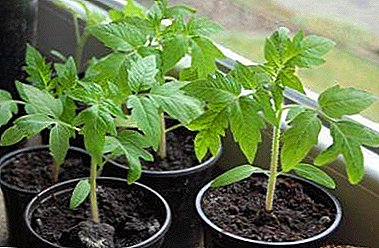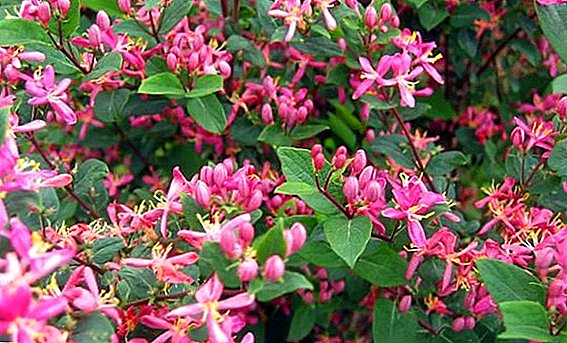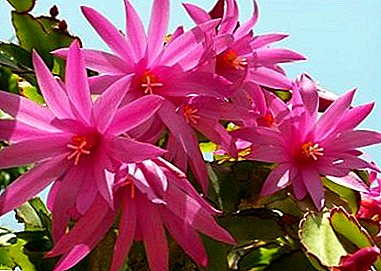
“Forest cacti” is one of the most interesting representatives of its kind.
They have long been loved by many gardeners and are often grown in an apartment as an indoor flower.
It harmoniously decorates any interior of a modern apartment.
Attracts attention to the beauty of flowering and easy care.
Among the different species, the Ripsalidopsis cactus (Easter cactus, rhipsalidopsis) is in particular demand.
Origin and characteristics
Its homeland is the territory of South America, where it grows in tropical rain forests, settling on trees, hollows, crevices of trunks, on stumps among a cluster of foliage.
It differs from simple desert cacti not only in appearance, but also in features of proper care. In apartments it is often grown in hanging pots or baskets. Stems as they grow long and begin to slide down.
Interesting! In nature, the flower grows in conditions of high humidity, in dark places.
Air roots are adapted to absorb moisture from the air, and dense stems allow for good accumulation and retention of moisture after the rainy season.
Views of the "Easter Cactus" with photos
Gartner
It is a bushy, epiphytic plant, 15–20 cm in height, with flat hanging shoots. On branching shoots there are leaf-like small segments, with wavy edges and short prickles (6 cm in length, 0.5 in width). Stems can change color depending on the lighting.
Under moderate lighting, they have a light green color, and become bright reddish in bright sunlight. On the tops of the shoots are located yellow setae collected in bunches. Segments covered with light pubescence. This species is often grown in baskets and hanging pots. In nature, it grows in tropical Brazilian forests.
The photo shows the flower “Ripsalidopsis Garner” with proper care at home:

"Pink"
Epiphytic shrub with long stems, segments with toothed-crested edges 4-5 cm long. It has a charming, delicate flowering. The flowers are star-shaped, pink in color, with a bright yellow core.
At home it looks very compact, grows no more than 25-30 cm in length. Often grown in hanging pots, pots.
The photo shows the flower "Ripsalidopsis Pink" with proper care at home:

"Andromeda"
In appearance, similar to the previous members of the genus. Endowed with long, green, dangling stems with small segments 4-6 cm in length. Differs in large maroon-pink star-shaped flowers, up to 5-6 cm in diameter, with orange hearts. Flowering long.
The photo shows the flower "Ripsalidopsis Andromeda" with proper care at home:

"Auriga"
This type of flower growers is often confused with the "Zigokaktus Truncated" (Decembrist). It is endowed with dangling long stems with short segments, red-orange large flowers. Flowering time, in contrast to the winter Decembrist, falls on the spring-summer period. The appearance of flowers also differs.
The photo shows the flower "Ripsalidopsis Auriga" with proper care at home:
Ripsalidopsis Phoenix
This species is distinguished by large, star-shaped, delicate pink flowers with a rich orange stripe in the center of each petal. Heart orange with light stamens. Petals wide. Blossoms very plentifully, continuously. Shoots are small, green.
The photo shows the flower "Ripsalidopsis Phoenix" with proper care at home:

Home care
Flower growers should pay attention to the fact that "Ripsalidopsis" refers to the representative of forest cacti. Recommendations for care are different from those given for simple desert cacti.
Deustation after purchase
Care should start immediately after purchase. The flower should be immediately transplanted into a new spacious pot, with a drainage hole and a fresh substrate. Capacity in which the flower was on sale, is not suitable for continuous cultivation. It contains plants only in the store.
Selection of soil and capacity
The capacity is chosen approximately one size larger than the previous one in order for the flower to be comfortable and grow freely. At the bottom must make a drainage embankment.
Suitable moderately fertile soil, quite loose and rough. The best option is a clay-grain earth with the addition of charcoal and crushed brick as a drainage.
 Before planting, experienced florists advise to heat the soil (steaming in the oven), add half a teaspoon of chalk and superphosphate to slightly increase the acidity of the earth.
Before planting, experienced florists advise to heat the soil (steaming in the oven), add half a teaspoon of chalk and superphosphate to slightly increase the acidity of the earth.
The soil acidity should be about 4-6.
You can plant a flower in a special ground for succulents and cacti.
Lighting
"Ripsalidopsis" - one of the few plants that feels great in dark places from the sun.
It is suitable for growing on windows facing north, north-east. At the same time on the east and west side flowering will be more abundant.
To the bush was more voluminous, and the flowering is uniform, it is possible from time to time to turn the flower to the light in different directions. Changing the position of the pot is necessary only before the formation of buds, otherwise the flowering will not be long.
Temperature
Important! The room should be comfortable, moderate temperature: in the summer around 20-23 degrees and 16-18 in the winter.
The cactus does not like heat and does not tolerate it well. In the summer hot months, it is better to rearrange the pot from the window in a dark, cool place.
In dry warm weather, you can take the pot outside so that the plant can breathe and air.
Protect the flower from drafts and temperature drops.
Air humidity
 In nature, cactus grows in tropical forests with high humidity.
In nature, cactus grows in tropical forests with high humidity.
The apartment should try to create conditions for it close to the natural environment.
In a room with dry air, it is recommended to purchase a floor-mounted humidifier.
In the spring and summer often spray the plant with water.
Stem from time to time, gently wipe with a damp cloth to remove dust and freshen up.
Watering
Note! During the year, the irrigation regime is constantly changing.
In the spring and summer, watering should be regular and frequent, so that the earth does not completely dry out.
From the flowering period, Ripsalidopsis needs more intensive, abundant watering.
The soil during this period should always be moist, but not flooded. During watering, try not to let the water fall into the flowers.
With the approach of cold weather, watering is suspended. In winter, there comes a time of rest, during which the earth is practically not moistened.
Fertilizers
In the period of active growth, “Ripsalidopsis” is fed every two weeks. Ready-made fertilizers for forest cacti are suitable for this. In the dormant period, the cactus is not fertilized.
Important! Flower can not be fed organic fertilizers.
Choose only minerals with low nitrogen content. Nitrogen can trigger root rot.
Bloom
The plant is not accidentally called "Easter cactus." Flowering time falls on Easter (approximately from the beginning of April). Remember that non-compliance with the recommendations for the care of the plant will adversely affect flowering.
Transfer
 The young cactus needs an annual transplant, which is carried out in May after the end of flowering.
The young cactus needs an annual transplant, which is carried out in May after the end of flowering.
Adult cactus transplanted much less frequently, about once every 2-3 years.
The root system of Ripsalidopsis is small, it requires a good supply of oxygen.
For transplanting, give the choice to a small, wide pot.
If the roots do not grow much from the previous transplant, you should not choose a large capacity.
The plant is carefully removed from the pot and shake off the roots of the old soil. Then put in a new container, gently straighten the roots and sprinkled with earth. On top of a little compacted fingers.
If during the summer the flower has grown strongly, you need to re-transplant it before the onset of cold weather.
Breeding
Cactus is easily propagated by cuttings, or rather by one segment of the stem, resembling the appearance of a leaf:
- Reproduction is carried out from November to January.
- The segment is carefully separated from the stem, dried for 2 weeks on a sheet of paper.
Then the cuttings are planted in a small pot (5-6 cm). It is better to take 2-3 segments for planting at once. Moist sphagnum (peat moss) is preferred as a filler.
Moisturize the substrate should be once a week. Too much moisture can cause rot. The cuttings are seated 5 months after planting.
Another method of reproduction - seeds.
For this, it is pollinated with pollen from another species of Ripsalidopsis. After pollination, a berry will appear in place of the flower, in which the seeds will ripen.
The fruit can stay long on the bush. Seeds sometimes germinate inside and turn into small spherical plants that can be placed in the soil. Seeds can be stored for 2-3 years.
This method of reproduction is laborious and long. A normal shrub is formed from seedlings only for 4 years after planting.
Diseases and pests
Note! that diseases arise as a result of inadequate care of the plant.
The most common ones are:

- Root rot. Associated with excessive soil moisture. It is very important to detect the disease in time and transplant the plant into a new substrate, otherwise it will die. During the transplantation, the root system must be thoroughly rinsed from rot, removed affected parts, sanitized in a weak solution of potassium permanganate.
- Of the fungal diseases, the most common are phthium, phytophthora, fusarium. Fusarium flower can become infected through wounds on the surface of the stems or after insect bites. For the treatment, fungicides with the components benomyl and chlorothalonil are used. Phithium and phytophthora infect the root collar through the contaminated soil. For the treatment using fungicidal drugs for fungal diseases.
- Of the pests, the plant can be affected by a mealy worm. It is difficult to notice because it affects the root system. An effective method of struggle is transplanting into a new soil with pre-treatment with insecticides and a weak solution of potassium permanganate.
Ripsalidopsis is an amazing, beautiful, exotic plant that many growers love to grow. It attracts the attention of charming flowering and unusual appearance.
If you want to purchase this flower, you should carefully read the recommendations for proper care. Unlike simple desert cacti, caring for forest representatives will be different. If you treat the flower with attention and care, it can become a real decoration of your home.


